Age and Origin of the Mesoproterozoic Iron Oxide-Apatite Mineralization, Cheever Mine, Eastern Adirondacks, NY
Abstract
1. Introduction
2. Geological Setting
3. Analytical Methods
4. Results
5. Discussion
6. Conclusions
Supplementary Materials
Author Contributions
Funding
Acknowledgments
Conflicts of Interest
Appendix A. Analytical Procedures
References
- Emmons, E. Geology of New York, Comprising the Survey of the Second Geological District. In Natural History of New York; Mather, W.W., Ed.; Carroll and Cook: Albany, NY, USA, 1842; Volume 4. [Google Scholar]
- Jonsson, E.; Troll, V.R.; Högdahl, K.; Harris, C.; Weis, F.; Nilsson, K.P.; Skelton, A. Magmatic origin of giant ‘Kiruna-type’ apatite-iron-oxide ores in central Sweden. Sci. Rep. 2013, 3, 1644. [Google Scholar] [CrossRef] [PubMed]
- Maynard, G.W. The iron ores of Lake Champlain. J. Br. Iron Steel Inst. 1874, 8, 109–136. [Google Scholar]
- McKeown, F.A.; Klemic, H. Rare-Earth-Bearing Apatite at Mineville, Essex County, New York; U.S. Geological Survey: Reston, VA, USA, 1956.
- Lupulescu, M.V.; Hughes, J.M.; Chiarenzelli, J.R.; Bailey, D.G. Texture, Crystal structure, and composition of fluorapatites from iron oxide-apatite (IOA) deposits, eastern Adirondack Mountains, New York. Can. Mineral. 2017, 755, 399–417. [Google Scholar] [CrossRef]
- Focus Graphite and SOQUEM Announce Positive PEA for the Kwyjibo REE Project in Québec. Available online: https://globenewswire.com/news-release/2018/06/28/1531111/0/en/Focus-Graphite-and-SOQUEM-Announce-Positive-PEA-for-the-Kwyjibo-REE-Project-in-Qu%C3%A9bec.html (accessed on 9 September 2018).
- Bilenker, L.; Reich, M.; Simon, A.; Munizaga, R. Fe-O stable isotope pairs elucidate a high-temperature origin of Chilean iron oxide-apatite deposits. Geochim. Cosmochim. Acta 2016, 77, 94–104. [Google Scholar] [CrossRef]
- Hildebrand, R.S. Kiruna-type deposits: Their origin and relationship to intermediate subvolcanic plutons in the Great Bear magmatic zone, Northwestern Canada. Econ. Geol. 1986, 81, 640–659. [Google Scholar] [CrossRef]
- Hitzman, M.W.; Oreskes, N.; Einaudi, M.T. Geological characteristics and tectonic setting of Proterozoic iron oxide (Cu-U-Au-REE) deposits. Precambrian Res. 1992, 58, 241–287. [Google Scholar] [CrossRef]
- Corriveau, L.; Montreuil, J.-F.; Potter, E.G. Alteration facies linkages among IOCG, IOA and affiliated deposits in the Great Bear magmatic zone, Canada, in Slack, J., Corriveau, L. and Hitzman, M., eds., Proterozoic iron oxide-apatite (±REE) and iron oxide-copper-gold and affiliated deposits of Southeast Missouri, USA, and the Great Bear magmatic zone, Northwest Territories, Canada. Econ. Geol. 2016, 111, 2045–2072. [Google Scholar]
- Corriveau, L. Iron-Oxide and Alkali-Calcic Alteration Ore Systems and Their Polymetallic IOA, IOCG, Skarn, Albitite-Hosted U±Au±Co, and Affiliated Deposits: A Short Course Series; Part 1: Introduction: Geological Survey of Canada; Scientific Presentation 56; Natural Resources Canada: Ottawa, ON, Canada, 2017; p. 80.
- Valley, P.M.; Hanchar, J.M.; Whitehouse, M.J. Direct dating of Fe oxide-(Cu-Au) mineralization by U/Pb zircon geochronology. Geology 2009, 37, 223–226. [Google Scholar] [CrossRef]
- Valley, P.M.; Hanchar, J.M.; Whitehouse, M.J. New insights on the evolution of the Lyon Mountain Granite and associated Kiruna-type magnetite-apatite deposits, Adirondack Mountains, New York State. Geosphere 2011, 7, 357–389. [Google Scholar] [CrossRef]
- Westhues, A.; Hanchar, J.M.; Voisey, C.R.; Whitehouse, M.J.; Rossman, G.R.; Wirth, R. Tracing the fluid evolution of the Kiruna iron oxide apatite deposits using zircon, monazite, and whole rock trace elements and isotopic studies. Chem. Geol. 2017, 466, 303–322. [Google Scholar] [CrossRef]
- Westhues, A.; Hanchar, J.M.; LeMessurier, M.J.; Whitehouse, M.J. Evidence for hydrothermal alteration and source regions for the Kiruna iron oxide–apatite ore (northern Sweden) from zircon Hf and O isotopes. Geology 2017, 45, 571–574. [Google Scholar] [CrossRef]
- Valley, P.M.; Fisher, C.; Hanchar, J.; Lam, R.; Tubrett, M. Hafnium isotopes in zircon: A tracer of fluid-rock interaction during magnetite–apatite (“Kiruna-type”) mineralization. Chem. Geol. 2010, 275, 208–220. [Google Scholar] [CrossRef]
- Childress, T.; Simon, A.; Day, W.; Lundstrom, C.; Bindeman, I. Iron and Oxygen Isotope Signatures of the Pea Ridge and Pilot Knob Magnetite-Apatite Deposits, Southeast Missouri, USA. Econ. Geol. 2016, 111, 2033–2044. [Google Scholar] [CrossRef]
- Dare, S.A.; Barnes, S.J.; Beaudoin, G. Did the massive magnetite “lava flows” of El Laco (Chile) form by magmatic or hydrothermal processes? New constraints from magnetite composition by LA-ICP-MS. Miner. Depos. 2015, 50, 607–617. [Google Scholar] [CrossRef]
- Nyström, J.O.; Henriquez, F. Magmatic features of iron ores of the Kiruna type in Chile and Sweden; ore textures and magnetite geochemistry. Econ. Geol. 1994, 89, 820–839. [Google Scholar] [CrossRef]
- Hofstra, A.; Meighan, C.; Song, X.; Samson, I.; Marsh, E.; Lowers, H.; Emsbo, P.; Hunt, A. Mineral thermometry and fluid inclusion studies of the Pea Ridge iron oxide-apatite-rare earth element deposit, Mesoproterozoic St. Francois Mountains Terrane, southeast Missouri, USA. Econ. Geol. 2016, 111, 1985–2016. [Google Scholar] [CrossRef]
- Knipping, J.; Bilenker, L.; Simon, A.; Reich, M.; Barra, F.; Deditius, A.; Lundstrom, C.; Bindeman, I.; Munizaga, R. Giant Kiruna-type deposits form by efficient flotation of magmatic magnetite suspensions. Geology 2015, 43, 591–594. [Google Scholar] [CrossRef]
- Nyström, J.O. Apatite iron ores of the Kiruna Field, northern Sweden: Magmatic textures and carbonatitic affinity. Geologiska Föreningen i Stockholm Förhandlingar 1985, 107, 133–141. [Google Scholar] [CrossRef]
- Nyström, J.O.; Henríquez, F.; Naranjo, J.A.; Naslund, H.R. Magnetite spherules in pyroclastic iron ore at El Laco, Chile. Am. Miner. 2016, 101, 587–595. [Google Scholar] [CrossRef]
- Rivers, T. Upper-crustal orogenic lid and mid-crustal core complexes: Signature of a collapsed orogenic plateau in the hinterland of the Grenville Province. Can. J. Earth Sci. 2012, 49, 1–42. [Google Scholar] [CrossRef]
- Frost, C.B.; Frost, B.R. Proterozoic ferroan feldspathic magmatism. Precambrian Res. 2013, 228, 151–163. [Google Scholar] [CrossRef]
- Roden-Tice, M.T.; Tice, S.T. Regional-scale Mid-Jurassic to Late Cretaceous unroofing from the Adirondack Mountains through central New England based on apatite fission-track and (U-Th)/He thermochronology. J. Geol. 2005, 113, 535–552. [Google Scholar] [CrossRef]
- Lowe, D.G.; Arnott, R.W.C.; Chiarenzelli, J.R.; Rainbird, R.H. Early Paleozoic rifting and reactivation of a passive-margin rift: Insights from detrital zircon provenance signatures of the Potsdam Group, Ottawa graben. Geol. Soc. Am. Bull. 2018, 130, 1377–1396. [Google Scholar] [CrossRef]
- Wynne-Edwards, H.R. The Grenville Province. In Variations in Tectonic Styles in Canada; Special Paper; Price, R.A., Douglas, R.J.W., Eds.; Geological Association of Canada: St. John’s, NL, Canada, 1972; Volume 11, pp. 263–334. [Google Scholar]
- Moore, J.M.; Thompson, P. The Flinton Group: A late Precambrian metasedimentary succession in the Grenville Province of eastern Ontario. Can. J. Earth Sci. 1980, 17, 1685–1707. [Google Scholar] [CrossRef]
- Rivers, T.; Martignole, J.; Gower, F.; Davidson, A. New tectonic divisions of the Grenville Province, southeast Canadian Shield. Tectonics 1989, 8, 63–84. [Google Scholar] [CrossRef]
- Mezger, K.; van der Pluijm, B.A.; Essene, E.J.; Halliday, A.N. The Carthage-Colton Mylonite Zone (Adirondack Mountains, New York): The site of a cryptic suture in the Grenville Orogen? J. Geol. 1992, 100, 630–638. [Google Scholar] [CrossRef]
- Bonamici, C.E.; Kozdon, R.; Ushikubo, T.; Valley, J.W. High-resolution P-T-t paths from δ18O zoning in titanite: A snapshot of late-orogenic collapse in the Grenville of New York. Geology 2011, 39, 959–962. [Google Scholar] [CrossRef]
- Selleck, B.W.; McLelland, J.; Bickford, M.E. Granite emplacement during tectonic exhumation: The Adirondack example. Geology 2005, 33, 781–784. [Google Scholar] [CrossRef]
- McLelland, J.; Selleck, B. Megacrystic Gore Mountain–type garnets in the Adirondack Highlands: Age, origin, and tectonic implications. Geosphere 2011, 7, 1194–1208. [Google Scholar] [CrossRef]
- Chiarenzelli, J.; McLelland, J. Granulite facies metamorphism, paleoisotherms, and disturbance of the U-Pb systematics of zircon in anorogenic plutonic rocks from the Adirondack Highlands. J. Metamorph. Geol. 1992, 11, 59–70. [Google Scholar] [CrossRef]
- Heumann, M.J.; Bickford, M.E.; Hill, B.M.; Selleck, B.W.; Jercinovic, M.J. Timing of anatexis in metapelites from the Adirondack Lowlands and Southern Highlands: A manifestation of the Shawinigan orogeny and subsequent anorthosite-mangerite-charnockite-granite (AMCG) magmatism. Geol. Soc. Am. Bull. 2006, 118, 1283–1298. [Google Scholar] [CrossRef]
- Chiarenzelli, J.; Valentino, D.; Lupulescu, M.; Thern, E.; Johnston, S. Differentiating Shawinigan and Ottawan orogenesis in the Central Adirondacks. Geosphere 2011, 7, 2–22. [Google Scholar] [CrossRef]
- Chiarenzelli, J.; Kratzmann, D.; Selleck, B.; de Lorraine, W. Age and provenance of Grenville Supergroup rocks, Trans-Adirondack Basin, constrained by detrital zircons. Geology 2015, 43, 183–186. [Google Scholar] [CrossRef]
- Lupulescu, M.; Chiarenzelli, J.; Pullen, A.; Price, J. Using pegmatite geochronology to constrain temporal events in the Adirondack Mountains. Geosphere 2011, 7, 23–39. [Google Scholar] [CrossRef]
- Chiarenzelli, J.; Selleck, B.; Lupulescu, M.; Regan, S.; Bickford, M.E.; Valley, P.; McLelland, J. Lyon Mountain ferroan leucogranite suite: Response to collision, thickened crust, and extension in the core of the Grenville Orogen. Geol. Soc. Am. Bull. 2017, 129, 1472–1488. [Google Scholar] [CrossRef]
- McLelland, J.; Hamilton, M.; Selleck, B.; McLelland, J.M.; Walker, D.; Orrell, S. Zircon U-Pb geochronology of the Ottawan orogeny, Adirondack Highlands, New York: Regional and tectonic implications. Precambrian Res. 2001, 109, 39–72. [Google Scholar] [CrossRef]
- McLelland, J.; Morrison, J.; Selleck, B.; Cunningham, B.; Olson, C.; Schmidt, K. Hydrothermal alteration of late- to post-tectonic Lyon Mountain granitic gneiss, Adirondack Mountains, New York: Origin of quartz-sillimanite segregations, quartz-albite lithologies, and associated Kiruna-type low Ti-Fe-oxide deposits. J. Metamorph. Geol. 2002, 20, 175–190. [Google Scholar] [CrossRef]
- Kemp, J.F. The Mineville-Port Henry mine group in Geology of the Adirondack magnetic iron ores, Newland, D.H., Ed. N. Y. State Mus. Bull. 1908, 119, 57–88. [Google Scholar]
- Regan, S.; Lupulescu, M.; Jercinovic, M.; Singer, J.; Geer, P.; Chiarenzelli, J.; Williams, M.; Walsh, G. Geochronology of IOA-type deposits: What are we dating? Geol. Soc. Am. Abstr. Programs 2016, 48, 7. [Google Scholar]
- Chew, D.; Sylvester, P.; Tubrett, M. U–Pb and Th–Pb dating of apatite by LA-ICPMS. Chem. Geol. 2013, 280, 200–216. [Google Scholar] [CrossRef]
- Ludwig, K. Isoplot 3.7 and 4.1; Berkeley Geochronology Center: Berkeley, CA, USA, 2008; Available online: https://www.bgc.org/isoplot_etc/isoplot.html (accessed on 9 September 2018).
- Sun, S.S.; McDonough, W.F. Chemical and Isotopic Systematics of Oceanic Basalts; Saunders, A.D., Norry, M.J., Eds.; Geological Society of London: London, UK, 1989; Volume 42, pp. 313–345. [Google Scholar]
- Condit, C.; Mahan, K.; Curtis, K.; Moeller, A. Dating metasomatism: Monazite and zircon growth during amphibolite facies albitization. Minerals 2018, 8, 187. [Google Scholar] [CrossRef]
- Wu, Y.; Zheng, Y. Genesis of zircon and its constraints on the interpretation of U-Pb age. Chin. Sci. Bull. 2004, 49, 1554–1569. [Google Scholar] [CrossRef]
- Pelleter, E.; Cheilletz, A.; Gasquet, D.; Mouttaqi, A.; Annich, M.; Deloule, E. Hydrothermal zircons: A tool for ion microprobe U-Pb dating of ore mineralization in polyphase deposits. Chem. Geol. 2007, 245, 135–161. [Google Scholar] [CrossRef]
- Fu, B.; Mernagh, T.P.; Kita, N.T.; Kemp, A.I.; Valley, J.W. Distinguishing masgmatic zircon for hydrothermal zircon: A case study from the Gidinburh high-sulphidation Au-Ag-(Cu) deposit of SE Australia. Chem. Geol. 2009, 259, 131–148. [Google Scholar] [CrossRef]
- Miller, C.F.; McDowell, S.M.; Mapes, R.W. Hot and cold granites? Implications of zircon saturation temperatures and preservation of inheritance. Geology 2003, 31, 529–532. [Google Scholar] [CrossRef]
- Valley, J.W.; Reinhard, D.A.; Cavosie, A.J.; Ushikubo, T.; Lawrence, D.F.; Larson, D.J.; Kelly, T.F.; Snoeyenbos, D.R.; Strickland, A. Nano- and micro-geochronology in Hadean and Archean zircons by atom-probe tomography and SIMS: New tools for old minerals. Am. Miner. 2015, 100, 1355–1377. [Google Scholar] [CrossRef]
- Hynes, A.; Rivers, T. Protracted continental collision—Evidence from the Grenville Orogen. Can. J. Earth Sci. 2010, 47, 591–620. [Google Scholar] [CrossRef]
- McLelland, J.; Chiarenzelli, J.; Whitney, P.; Isachsen, Y. U-Pb zircon geochronology of the Adirondack Mountains and implications for their geologic evolution. Geology 1988, 16, 920–924. [Google Scholar] [CrossRef]
- Gehrels, G.E.; Valencia, V.; Ruiz, J. Enhanced precision, accuracy, efficiency, and spatial resolution of U-Pb ages by laser ablation-multicollector inductively coupled plasma-mass spectrometry. Geochem. Geophys. 2008, 9, 1–13. [Google Scholar] [CrossRef]
- Stacey, J.S.; Kramers, J.D. Approximation of terrestrial lead isotope evolution by a two-stage model. Earth Planet. Sci. Lett. 1975, 26, 207–221. [Google Scholar] [CrossRef]
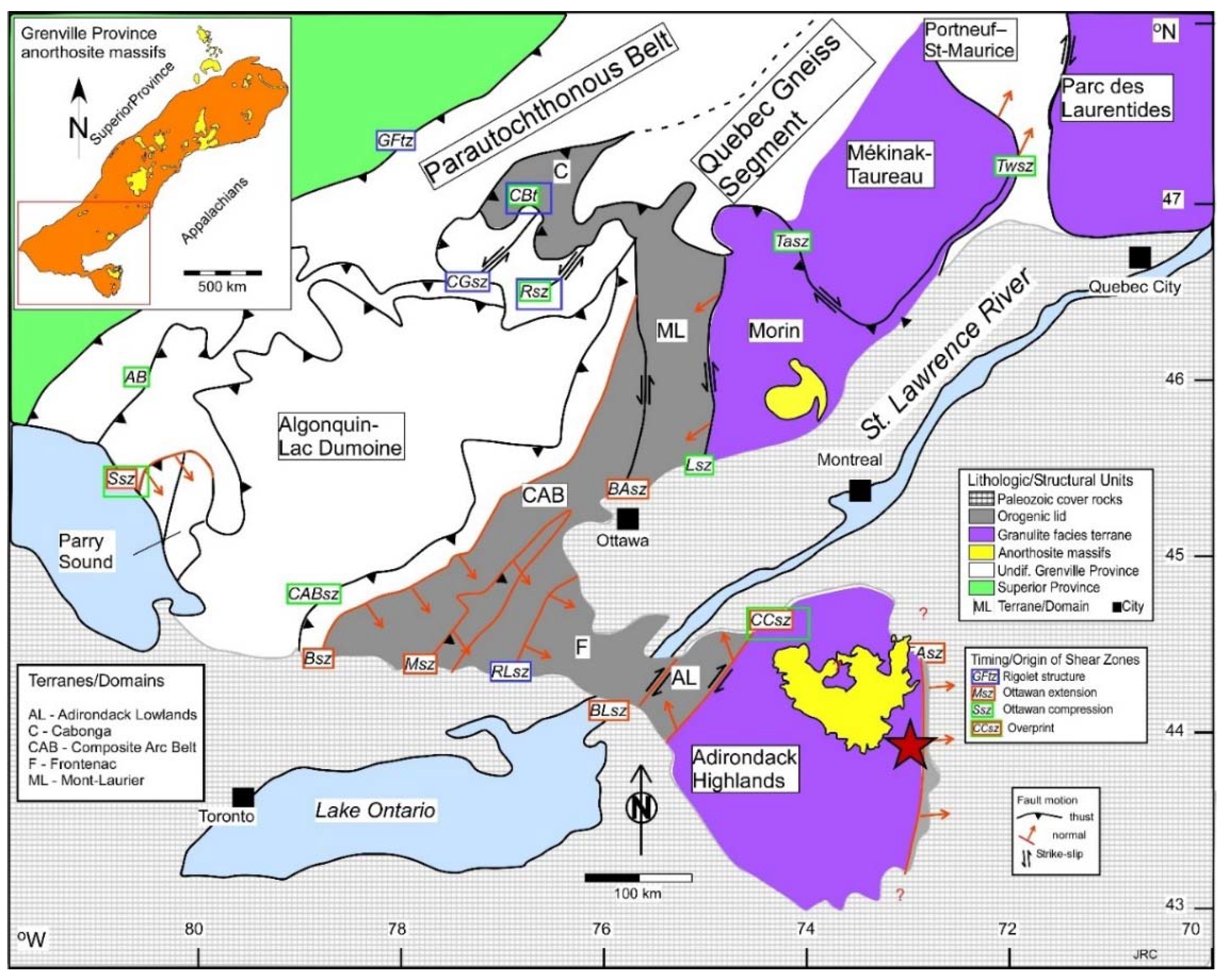
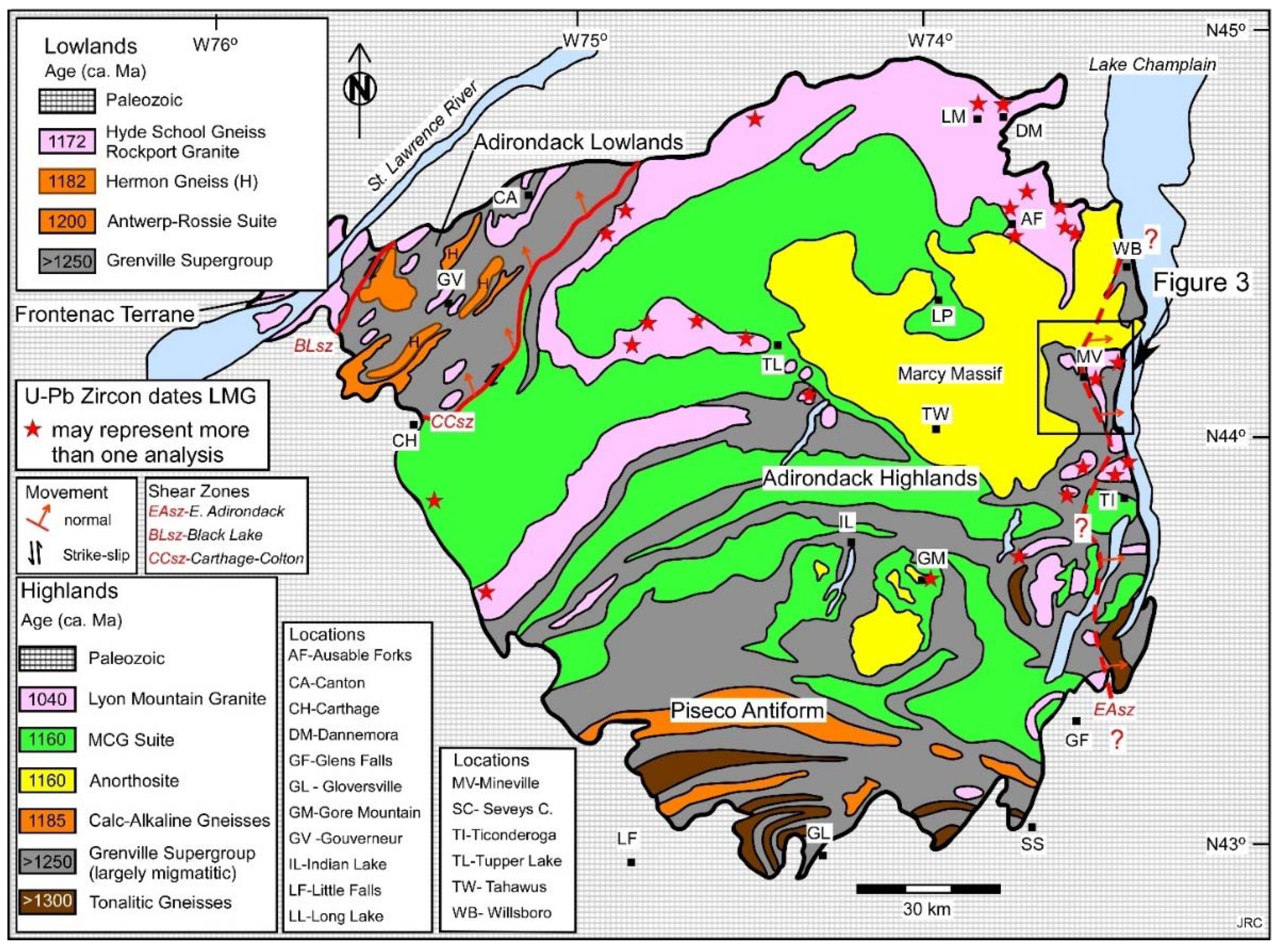
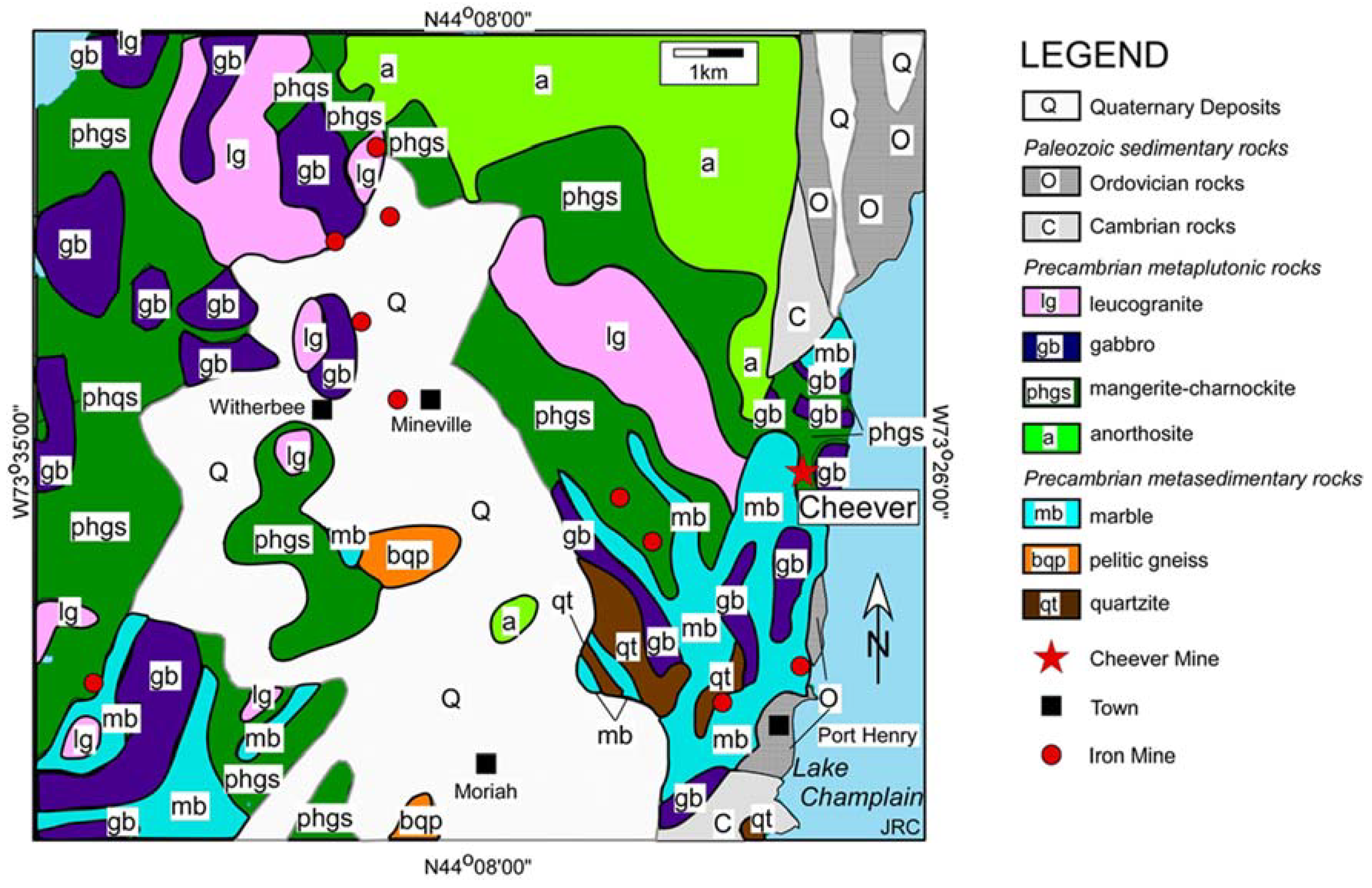
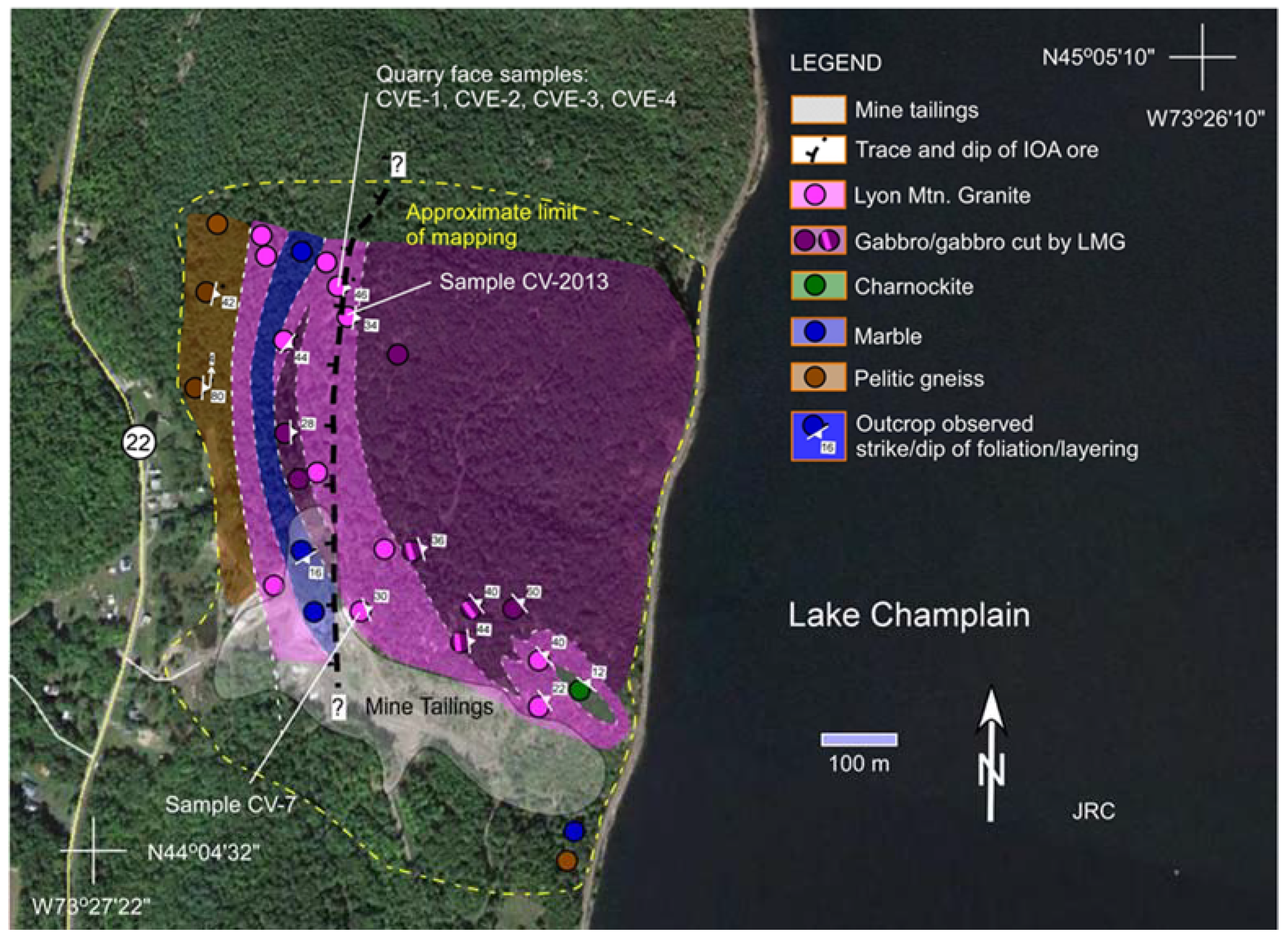
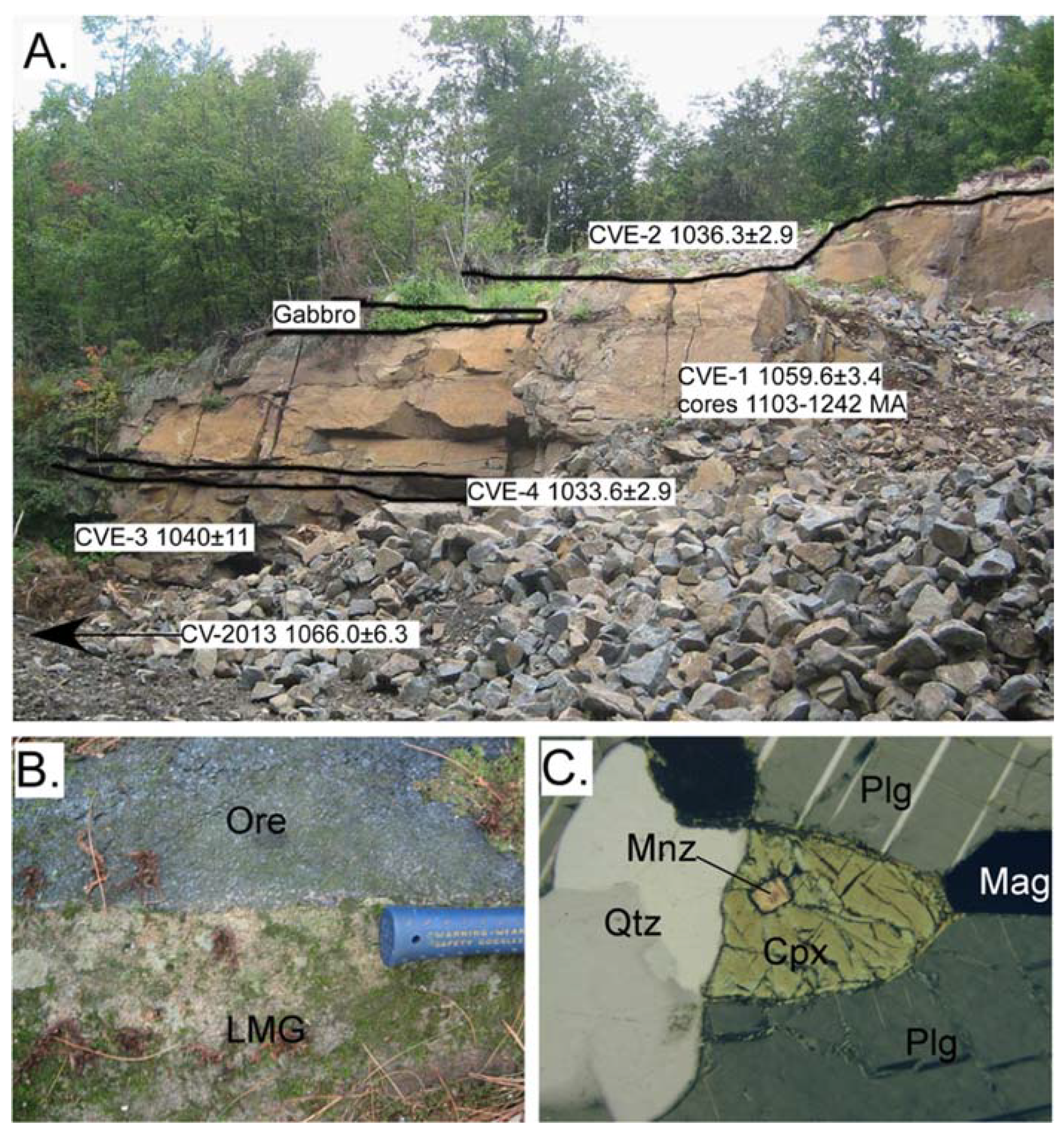
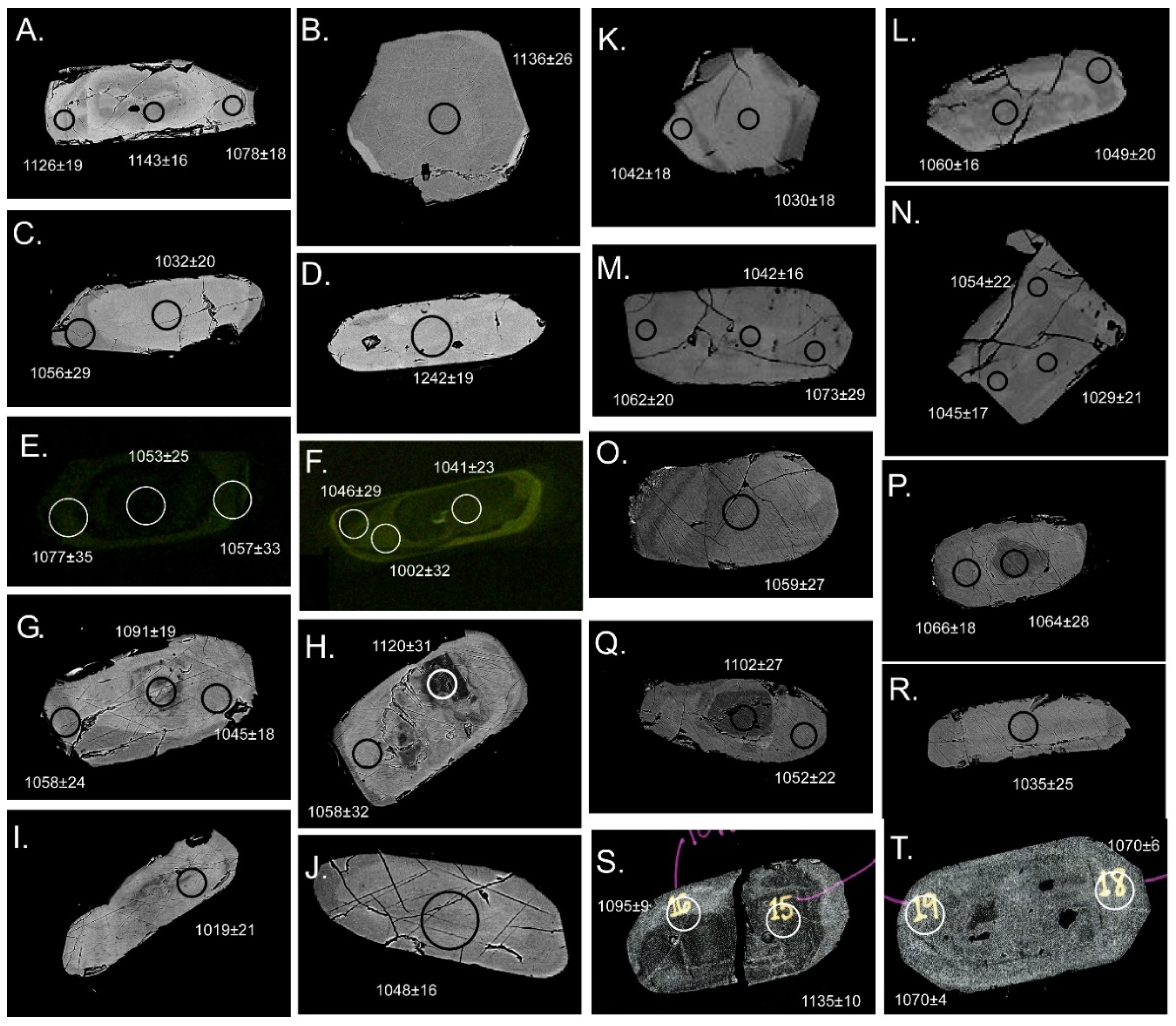
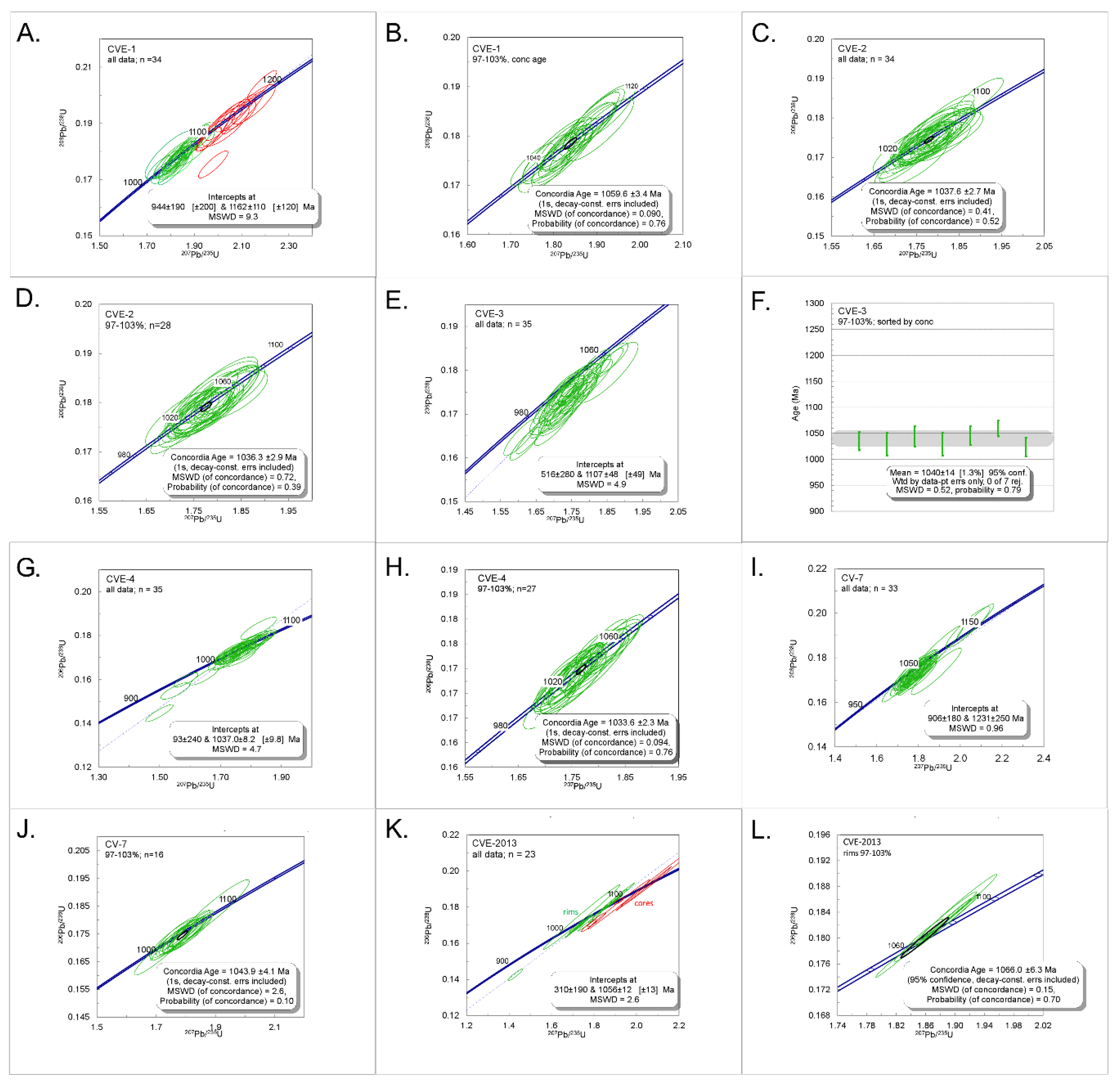
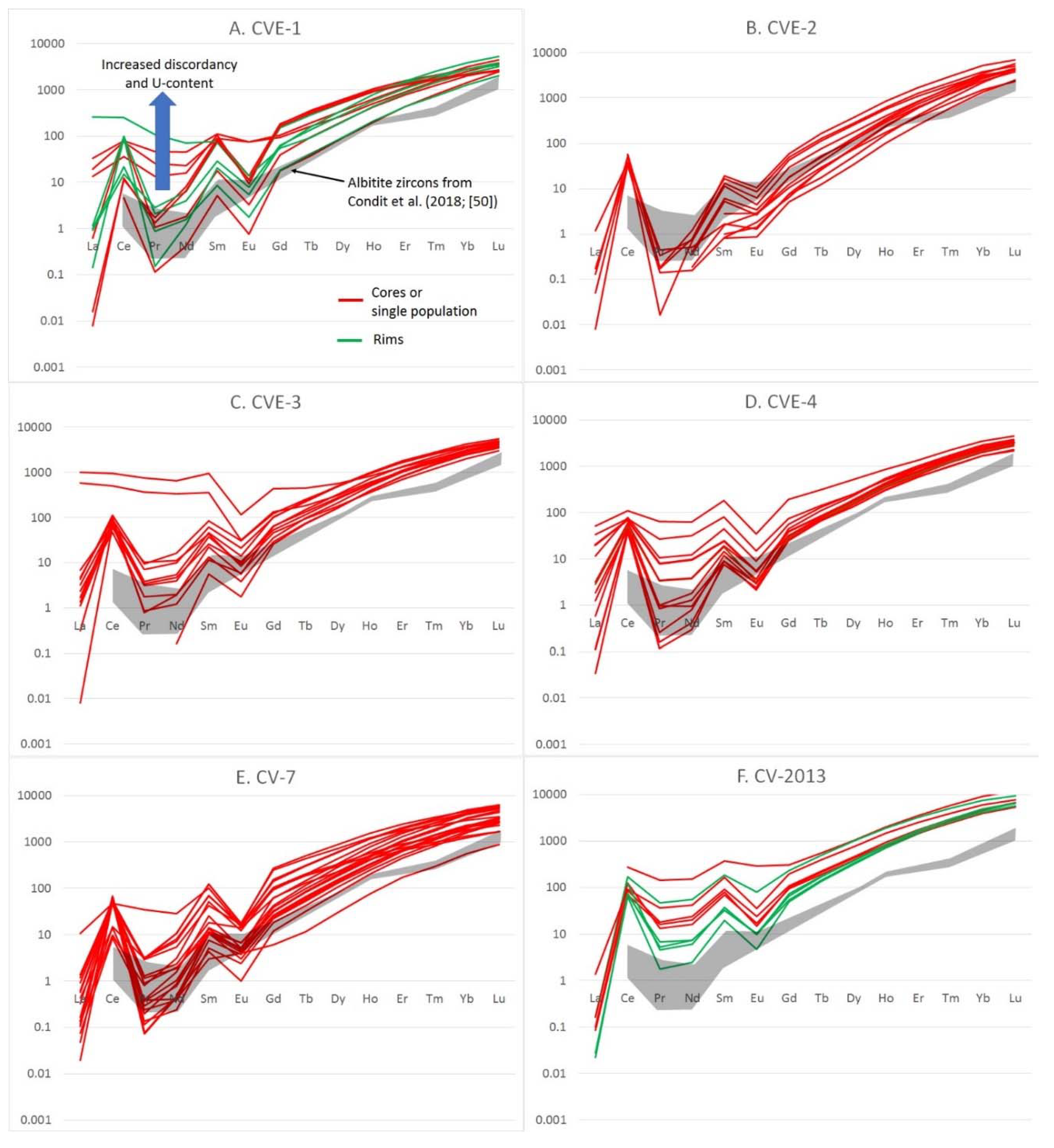

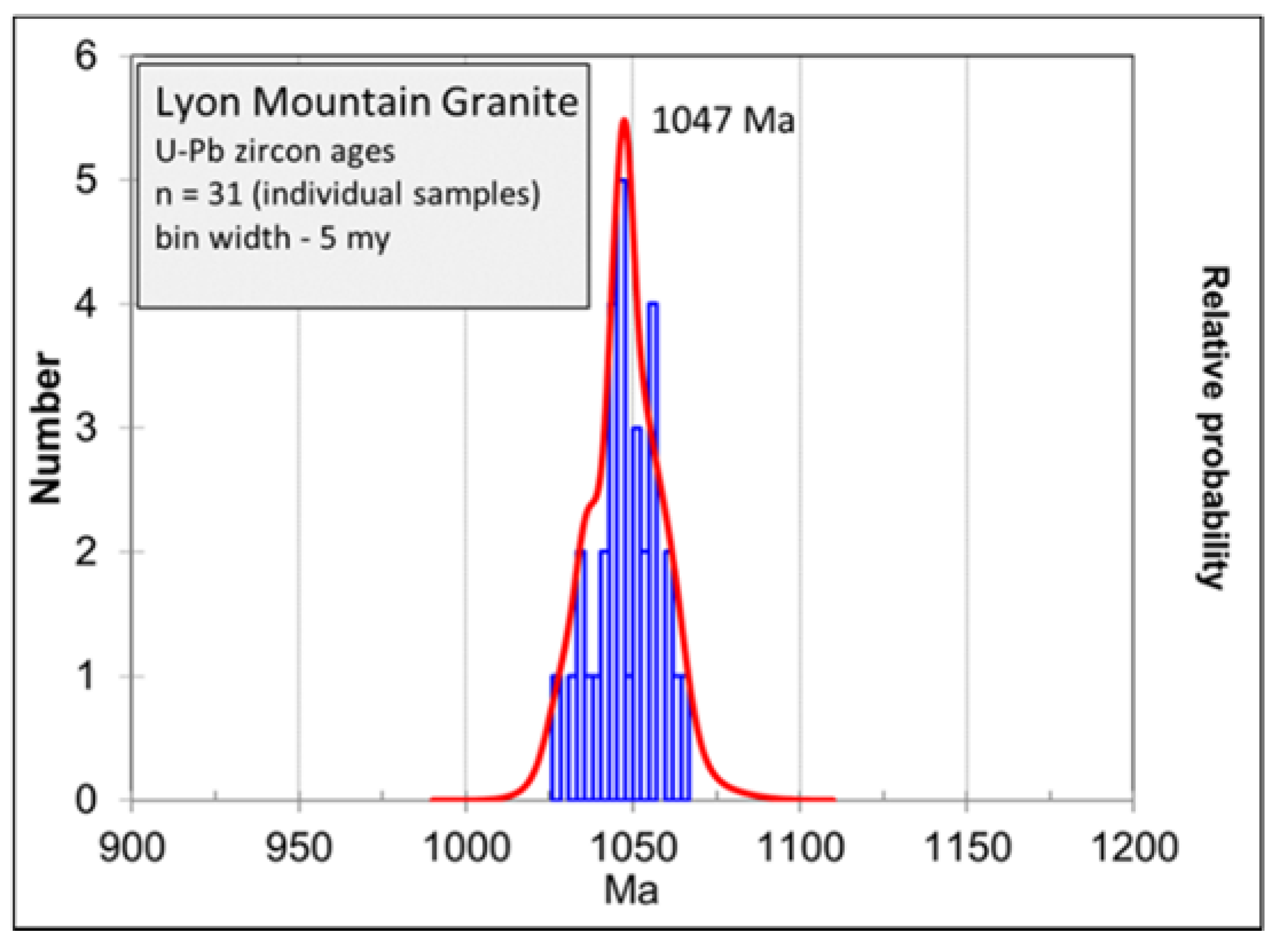
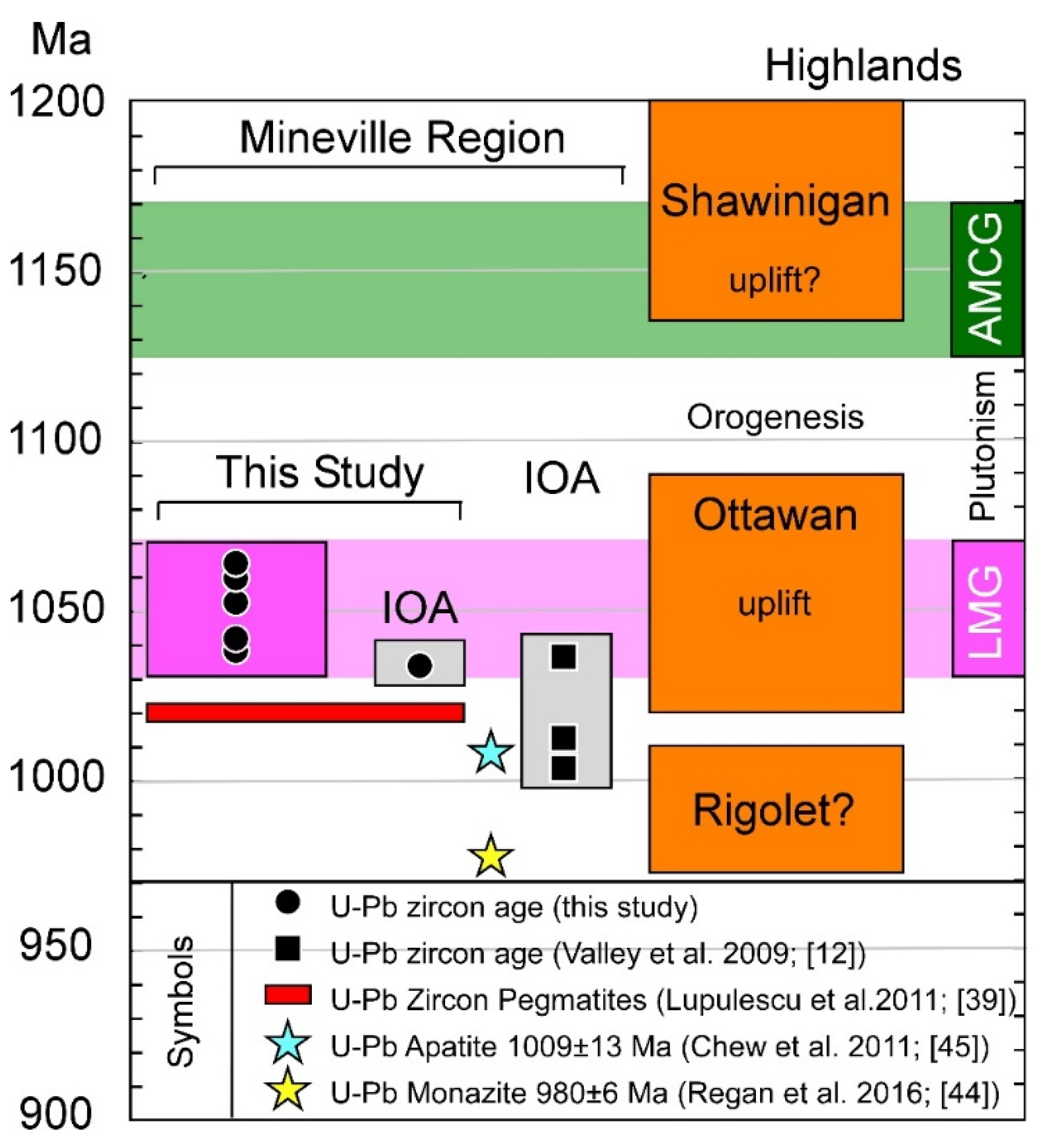
| Sample | SiO2 | TiO2 | Al2O3 | FeOT | MnO | MgO | CaO | Na2O | K2O | P2O5 | LOI | TOT |
|---|---|---|---|---|---|---|---|---|---|---|---|---|
| CVE-1 | 70.59 | 0.39 | 10.99 | 10.68 | 0.01 | 0.05 | 0.36 | 5.77 | 0.64 | 0.05 | 0.00 | 99.52 |
| CVE-2 | 80.28 | 0.33 | 10.35 | 1.41 | 0.01 | 0.11 | 0.57 | 4.80 | 1.40 | 0.01 | 0.23 | 99.27 |
| CVE-3 | 67.94 | 0.26 | 11.20 | 12.21 | 0.02 | 0.24 | 0.76 | 6.38 | 0.07 | 0.09 | 0.00 | 99.17 |
| CVE-4 | 4.95 | 0.70 | 0.49 | 86.97 | 0.07 | 0.23 | 2.65 | 0.29 | 0.07 | 2.90 | 0.00 | 99.32 |
| CV-7 | 65.93 | 0.47 | 14.40 | 8.68 | 0.02 | 0.08 | 0.56 | 9.03 | 0.20 | 0.09 | 0.00 | 99.46 |
| Sample Lat./Long. in DD | Lithology Dominant Minerals | Number Population 1 | Age (Ma) 2 | U (ppm) | U/Th Ratio |
|---|---|---|---|---|---|
| CVE-1 44.0814-73.4528 | Leucogranite Plg-Qtz-Mag | 21 rims 13 cores | 1059.6 ± 3.4 CA Cores 1103-1242 | 1149 ± 837 976 ± 696 | 10.1 ± 7.9 9.3 ± 11.0 |
| CVE-2 44.0814-73.4528 | Leucogranite Plg-Qtz-Per-Mag | 34/35 homogeneous | 1036.3 ± 2.9 CA | 188 ± 90 | 4.0 ± 1.0 |
| CVE-3 44.0814-73.4528 | Leucogranite Plg-Qtz-Cpx-Mag | 35/35 homogeneous | 1040 ± 11 WA | 1740 ± 294 | 11.2 ± 5.6 |
| CVE-4 44.0814-73.4528 | Ore Mag-Ap-Cpx-Qtz | 27/35 homogeneous | 1033.6 ± 2.9 CA | 986 ± 310 | 6.8 ± 4.5 |
| CV-7 44.0776-73.4506 | Leucogranite Plg-Qtz-Mag | 33/35 homogeneous | 1043.9 ± 4.1 CA | 665 ± 271 | 5.8 ± 2.0 |
| CV-2013 44.0802-73.4532 | Leucogranite Plg-Qtz-Mag-Cpx | 17 rims 6 cores | 1066.0 ± 6.3 CA Cores 1091-1136 | 1326 ± 234 1107 ± 474 | 6.4 ± 2.1 2.6 ± 1.4 |
| La | Ce | Pr | Nd | Sm | Eu | Gd | Tb | Dy | Ho | Er | Tm | Yb | Lu | |
|---|---|---|---|---|---|---|---|---|---|---|---|---|---|---|
| CVE-1 | 27.6 | 65.1 | 17.0 | 15.3 | 58.5 | 18.9 | 94.5 | 185.4 | 343 | 637 | 1064 | 1632 | 2457 | 3317 |
| CVE-2 | 0.1 | 40.6 | 0.1 | 0.4 | 6.7 | 3.9 | 22.2 | 61.5 | 147 | 359 | 785 | 1521 | 2880 | 4349 |
| CVE-3 | 135.8 | 187.3 | 96.9 | 87.2 | 137.2 | 21.6 | 101.0 | 173.8 | 328 | 640 | 1189 | 1941 | 3071 | 4251 |
| CVE-4 | 10.4 | 59.0 | 9.9 | 10.7 | 35.9 | 7.4 | 50.6 | 106.9 | 210 | 447 | 816 | 1410 | 2338 | 3179 |
| CV-7 | 0.9 | 44.9 | 2.8 | 4.3 | 36.0 | 8.7 | 75.2 | 155.8 | 307 | 610 | 1083 | 1692 | 2715 | 3708 |
| CV-2013 | 0.2 | 114.4 | 29.0 | 33.4 | 108.6 | 49.9 | 126.7 | 268.5 | 544 | 1104 | 2027 | 3364 | 5385 | 7229 |
© 2018 by the authors. Licensee MDPI, Basel, Switzerland. This article is an open access article distributed under the terms and conditions of the Creative Commons Attribution (CC BY) license (http://creativecommons.org/licenses/by/4.0/).
Share and Cite
Chiarenzelli, J.R.; Lupulescu, M.V.; Regan, S.P.; Singer, J.W. Age and Origin of the Mesoproterozoic Iron Oxide-Apatite Mineralization, Cheever Mine, Eastern Adirondacks, NY. Geosciences 2018, 8, 345. https://doi.org/10.3390/geosciences8090345
Chiarenzelli JR, Lupulescu MV, Regan SP, Singer JW. Age and Origin of the Mesoproterozoic Iron Oxide-Apatite Mineralization, Cheever Mine, Eastern Adirondacks, NY. Geosciences. 2018; 8(9):345. https://doi.org/10.3390/geosciences8090345
Chicago/Turabian StyleChiarenzelli, Jeffrey R., Marian V. Lupulescu, Sean P. Regan, and Jared W. Singer. 2018. "Age and Origin of the Mesoproterozoic Iron Oxide-Apatite Mineralization, Cheever Mine, Eastern Adirondacks, NY" Geosciences 8, no. 9: 345. https://doi.org/10.3390/geosciences8090345
APA StyleChiarenzelli, J. R., Lupulescu, M. V., Regan, S. P., & Singer, J. W. (2018). Age and Origin of the Mesoproterozoic Iron Oxide-Apatite Mineralization, Cheever Mine, Eastern Adirondacks, NY. Geosciences, 8(9), 345. https://doi.org/10.3390/geosciences8090345




